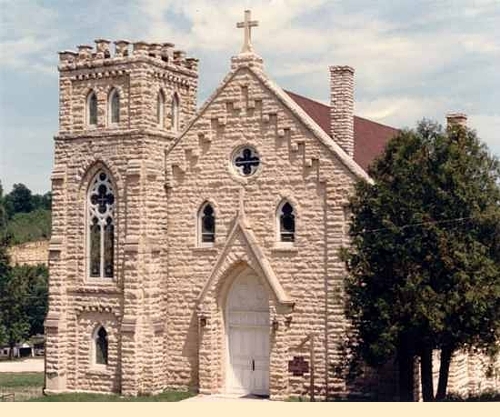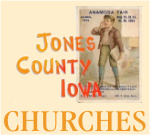
Anamosa is situated at the junction of two rivers — the Wapsipinicon and the Buffalo. Between them runs a strip of land, increasing in width, and rising to a considerable elevation, known familiarly as the "Ridge." Along the banks of each river, stone quarries were opened, beginning in 1853, from which large quantities of stone for building material, paving, and road material have been taken out, and shipped hundreds of miles in all directions. At present there are six quarries open on the Wapsie, and four on the Buffalo. They give work to a large number of men. After working all week, these employes have difficulty walking the eight miles to the nearest church in Anamosa on Sunday morning. Mr. J. A. Green, who employs the largest number of Catholics, generously proposed to provide the use of a large hall over the post office for use as a chapel. The hall was fitted up with a crude altar and benches for the purposes of Catholic services, which were held there for the first time in February, 1884. The room was called St. Joseph's Chapel.
At its formation, this was a chapel-of-ease, connected with Anamosa. While Father McCormick resided there he attended to both churches every Sunday, alternating early and late services between the two churches. Father Powers continued to give the same equal religious opportunities to the combined parishes up to September, 1902, when a resident pastor was appointed to Stone City. It has been an independent parish since, with the church on Buffalo Creek, two miles south of Prairieburg, attached to it as an out-mission. The Rev. P. J. Leddy was the first appointment to the charge. His mind failed, after a year and a half. His successor was Rev. J. Garland, who also resided at Stone City, giving the requisite attention to the out-mission, up to October, 1905. The next and present incumbent of this pastorate is the Rev. T. J. Norris. Besides Stone City and Prairieburg, he holds charge at this time of a third mission, at Lisbon, Linn county.
The parishioners here, both in number and in name, are a variable quantity. Some are permanent residents, others transient as labor requirements at the quarries vary by season. A large proportion of them are French-Canadians, or their descendants from the northern part of New York state. There are also some Germans among the quarrymen; and a few of almost every nationality in Europe. The first among them arrived in the sixties, as the stone business was operated on a very limited scale prior to that time. The following are the most prominent: J. A. Green, John Ronen, John Walsh, Theo. Hennessy, August Patnode, Ed. Mearns, Dunn Brothers, Betz Brothers, Sampica Brothers, Rushford Brothers, Denio Brothers, La Barge Brothers.
The cornerstone of St. Joseph’s Roman Catholic Church was laid in 1913. The first mass was held in 1914. The church was designed by Dubuque, Iowa architect Guido Beck. The stained glass windows of the church were imported from Germany. The limestone used for the building was donated by city quarries. The labor to construct the church was also donated by local quarry businesses. This building is on the U. S. National Register of Historic Places.






